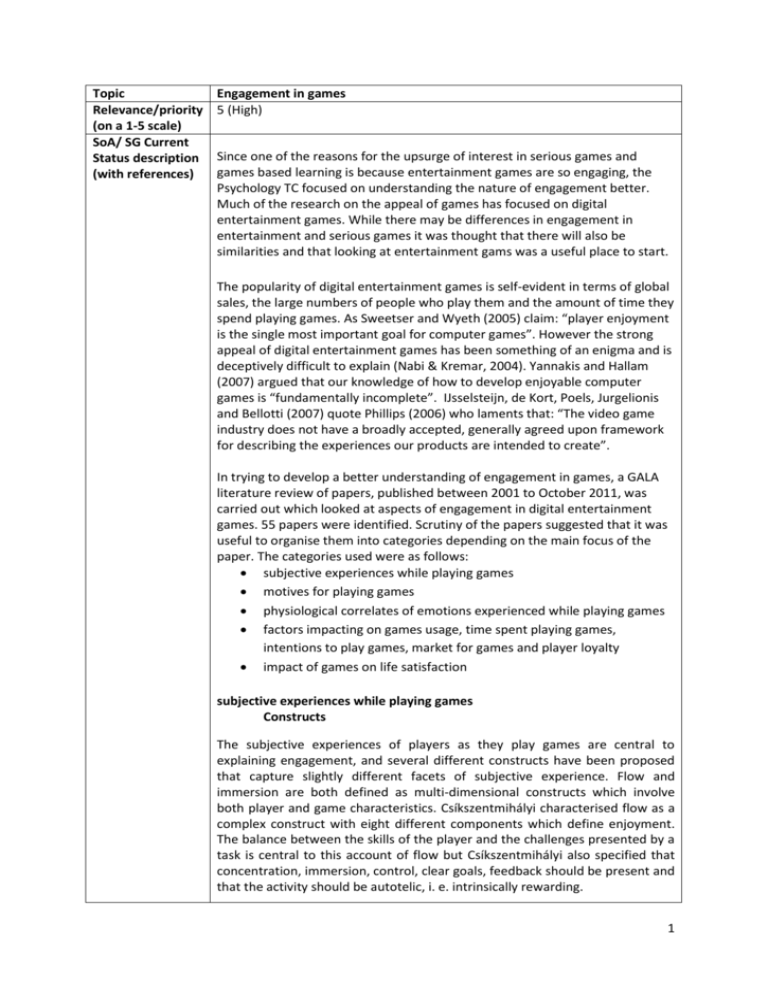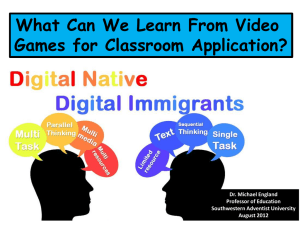TC 2.7 engagement
advertisement

Topic Relevance/priority (on a 1-5 scale) SoA/ SG Current Status description (with references) Engagement in games 5 (High) Since one of the reasons for the upsurge of interest in serious games and games based learning is because entertainment games are so engaging, the Psychology TC focused on understanding the nature of engagement better. Much of the research on the appeal of games has focused on digital entertainment games. While there may be differences in engagement in entertainment and serious games it was thought that there will also be similarities and that looking at entertainment gams was a useful place to start. The popularity of digital entertainment games is self-evident in terms of global sales, the large numbers of people who play them and the amount of time they spend playing games. As Sweetser and Wyeth (2005) claim: “player enjoyment is the single most important goal for computer games”. However the strong appeal of digital entertainment games has been something of an enigma and is deceptively difficult to explain (Nabi & Kremar, 2004). Yannakis and Hallam (2007) argued that our knowledge of how to develop enjoyable computer games is “fundamentally incomplete”. IJsselsteijn, de Kort, Poels, Jurgelionis and Bellotti (2007) quote Phillips (2006) who laments that: “The video game industry does not have a broadly accepted, generally agreed upon framework for describing the experiences our products are intended to create”. In trying to develop a better understanding of engagement in games, a GALA literature review of papers, published between 2001 to October 2011, was carried out which looked at aspects of engagement in digital entertainment games. 55 papers were identified. Scrutiny of the papers suggested that it was useful to organise them into categories depending on the main focus of the paper. The categories used were as follows: subjective experiences while playing games motives for playing games physiological correlates of emotions experienced while playing games factors impacting on games usage, time spent playing games, intentions to play games, market for games and player loyalty impact of games on life satisfaction subjective experiences while playing games Constructs The subjective experiences of players as they play games are central to explaining engagement, and several different constructs have been proposed that capture slightly different facets of subjective experience. Flow and immersion are both defined as multi-dimensional constructs which involve both player and game characteristics. Csíkszentmihályi characterised flow as a complex construct with eight different components which define enjoyment. The balance between the skills of the player and the challenges presented by a task is central to this account of flow but Csíkszentmihályi also specified that concentration, immersion, control, clear goals, feedback should be present and that the activity should be autotelic, i. e. intrinsically rewarding. 1 While flow is the term which has been the most widely used in explaining and trying to measure the appeal of games, but Jennett et al (2008) argued that immersion may be a more useful construct since it can exist to varying degrees on different tasks and consequently can explain a broader range of experiences than flow which refers only to states of optimal experience. Presence has a more specific focus than immersion or flow on the feelings of actually being present in the game. Consequently presence is highly dependent on the realism of the game. Nakatsu, Rauterberg and Vorderer (2005) distinguish between physical, mental and integrated presence. Arousal theory is useful in highlighting excitement as well as enjoyment as distinct emotions experienced by gamers and it also highlights the value of studying physiological correlates of emotions felt in playing games. Qualitative approaches to analyzing the nature of player engagement have helped to identify common constructs and develop a common vocabulary to describe and represent aspects of players’ experiences in games (Brown and Cairns, 2004; O’Brien and Toms, 2008; Poels, de Kort and IJsselsteijn, 2007). Poels et al’s focus group study of game experience dimensions, identified enjoyment, flow, imaginative immersion, sensory immersion, suspense, negative affect and social presence as important characteristics of players’ engagement with games. Few studies have examined links between subjective experience constructs, although an exception was Weibel et al (2008) who examined links between presence, flow and enjoyment in games. They confirmed their prediction that presence precedes flow with flow mediating the relationship between presence and enjoyment. Measures of engagement A number of authors have developed measures of subjective experience. For example, in developing their GameFlow model to measure enjoyment in computer games, Sweetser and Wyeth (2005) modified Csíkszentmihályi’s eight component model of flow. Fu et al (2009) added a knowledge improvement scale to Sweetser & Wyeth’s model of GameFlow to provide a measure of enjoyment in educational games. Some authors have developed short measures of flow tailored to their own interests: Weibel et al (2008) assessed involvement, concentration and optimal challenge; Lee and LaRose (2007) measured enjoyment, concentration, optimal balance between self-efficacy and challenge and merging of action and awareness. Jennett et al developed an immersion questionnaire which included three person-related factors: cognitive involvement, emotional involvement and real world dissociation, and two game-related factors: challenge and control. Witmer and Singer (1998) studied presence in detail and developed a 19-item presence questionnaire which assessed players’ feelings of being in the game and not in the real world. Ivory and Kalyanaraman (2007) assessed presence using a much shorter 3-item measure which looked at (a) the extent 2 to which players feel in the game environment and (b) how real the game environment feels and (c) how real the characters feel. Weibel et al (2008) used an 8-item presence scale which assessed the extent to which someone feels present (arrival) or not (departure) in the mediated environment. Brockmyer, Fox, Curtiss, McBroom and Burkhart (2009) opted for an eclectic definition of engagement in their Game Engagement Questionnaire, including items on flow, immersion, presence and adsorption. Physiological or behavioural measures Of course an important strand of research is to link these subjective measures with harder physiological or behavioural measures. Behavioural: a key behavioural indicator of engagement is the amount of time spent playing the game. Jennett used a behavioural measure of the time to re-engage in a task following game play as a measure of engagement Research on brain waves has been carried out in TC2.9 of the GALA project. Motives for playing games Over time, enjoyable feelings experienced while playing games will lead to positive attitudes and expectations of games which provide more enduring reasons or motives for playing games. Motives provide an alternative perspective on engagement which involves appraisals of feelings experienced while playing games. Tan (2008) made a useful theoretical distinction between “on-line phenomenal experiences of activities” and “selecting and engaging in activities” in discussing emotions linked to media. Motivational theories explain the appeal of games and reasons for playing games. Przybylski et al [28] used Ryan and Deci’s [29] self-determination theory to explain players’ motives for playing games. This theory provides an account of very broad based needs for competence, autonomy and relatedness that drive human behaviour and argues that people enjoy activities more if they meet intrinsic rather than extrinsic needs. Uses and gratifications (U&G) theory provides an account of more specific, media-related motives for playing games. Lucas and Sherry [30] applied U&G theory to playing games and found that players play games for challenge, the rather contradictory reasons of emotional arousal and relaxation, to compete against other players, for the ability to take part in fantasy activities which would not normally be possible and to interact socially with other players. Factors impacting on games usage, time spent playing games, intentions to play games, market for games and player loyalty The number of players, the amount of time spent playing games and the amount of money spent on buying games are obvious, if rather rough and ready, indicators of engagement in games. The number of individuals who regularly play digital video games in one mode or another is conservatively estimated to be in the range of 316,000,000 (Macchiarella, 2012) in the western world (European and U.S.) alone, although given the prevalence of digital video games in other world regions, specifically Asia and the Indian subcontinent, this number is in actuality likely to be significantly higher than 3 that quoted. Several models of game usage were identified (could possibly develop models as another topic?) Psychologists have applied models of technology use and attitudes to explaining attitudes to and acceptance of games. For example the Technology Acceptance Model (TAM) proposes perceived usefulness and perceived ease of use as two key factors in this. Hsu and Lu (2004) extended the Technology Acceptance Model (TAM) to leisure applications of IT, arguing that social norms (i. e. players’ perceptions of other people’s views of the technology), critical mass (the number of people using the technology) and flow are more relevant to explaining attitudes to and the use of on-line entertainment games. Hsu and Lu’s (2004) structural equation modelling study confirmed that perceived ease of use, usefulness and critical mass impacted on attitudes to online games, while social norms, attitudes to games and flow experience impacted directly on intention to play games. Hoffman and Novak (1996) proposed a process model of flow with skill, challenge, attention and tele-presence preceding flow and this then led to positive affect and exploratory behaviour. In a structural equation modelling study they confirmed the usefulness of this approach and in a more recent paper Hoffman and Novak (2009) extended this model incorporating constructs from the technology acceptance model and further acknowledging the value of process models of flow. The detailed model of spatial presence described by Wirth et al (2007) is also a process model, describing the sequence of cognitive processing leading to the feeling of presence, but also suggesting the inclusion of user and media factors as antecedents. Fernandez’ (2008) process model of user experience specifies characteristics of users (such as age, gender, educational experience, experience with games and motives) and characteristics of games (such as game genre, hardware and software) as antecedents of enjoyment. Topic Related to SOA Engagement in games Future research should aim to productively synthesise links between subjective experience constructs, or generate new perspectives or understandings. Future research should aim to link subjective (questionnaire based) and objective (behavioural and physiological) measures of engagement Learning and engagement A key issue is to link engagement and learning in games, since there is still a question mark over the compatibility of fun and learning. It seems likely that cognitive theories will be important in our understanding of engagement in games and may well be more important in serious games. Cognitive load theory in particular may be very useful in explaining how to develop maximally engaging experiences which do not overload players. 4 Description of trend (with references) Future research should continue to expand our understanding of the features of games and users that contribute to providing engaging game experiences and try to provide a more integrated account of how human needs and characteristics and game mechanics can work together to produce engaging games. Future research should aim to develop a more integrated & coherent account of how the affordances of games and the goals and activities that they present address players’ achievement-related, emotional and social needs and provide support for their information processing characteristics. It will also be useful to examine different kinds of engagement in different kinds of games. Future research should explore cognitive aspects of engagement in more detail. Cognitive approaches to understanding engagement would seem to be a useful way of linking engagement and learning. Distractor tasks have been widely used in studying attention and could be used in games research as behavioural measures of engagement (Beck and Lavie, 2005) Models of executive functions are likely to be useful in this respect. These can help to explain how players allocate attentional resources. Improvement in allocation of attentional resources seems to explain why playing action games leads to visual spatial benefits. It would also be useful to explore emotions experienced in games, especially interest which directs attention. The balance between negative and positive emotions felt in games is of interest, since the resolution of anxiety or fear would seem to be rewarding. Anxiety and relief; shame and pride; uncertainty and resolution of uncertainty. Future research should continue to develop models of games used based on Tam and the theory of planned behaviour. Beck, DM; Lavie, N. (2005), 'Look Here but Ignore What You See: Effects of Distracters at Fixation', Journal of Experimental Psychology: Human Perception and Performance 31(3), 592-607. Implications 5






